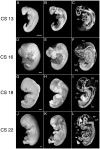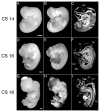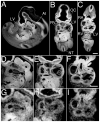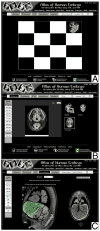Developmental atlas of the early first trimester human embryo
- PMID: 20503356
- PMCID: PMC3401072
- DOI: 10.1002/dvdy.22316
Developmental atlas of the early first trimester human embryo
Abstract
Rapid advances in medical imaging are facilitating the clinical assessment of first-trimester human embryos at increasingly earlier stages. To obtain data on early human development, we used magnetic resonance (MR) imaging and episcopic fluorescence capture (EFIC) to acquire digital images of human embryos spanning the time of dynamic tissue remodeling and organogenesis (Carnegie stages 13 to 23). These imaging data sets are readily resectioned digitally in arbitrary planes, suitable for rapid high-resolution three-dimensional (3D) observation. Using these imaging datasets, a web-accessible digital Human Embryo Atlas (http://apps.devbio.pitt.edu/humanatlas/) was created containing serial 2D images of human embryos in three standard histological planes: sagittal, frontal, and transverse. In addition, annotations and 3D reconstructions were generated for visualizing different anatomical structures. Overall, this Human Embryo Atlas is a unique resource that provides morphologic data of human developmental anatomy that can accelerate basic research investigations into developmental mechanisms that underlie human congenital anomalies.
Figures









References
-
- Arroyo-Jimenez Mdel M, Marcos P, Martinez-Marcos A, Artacho-Perula E, Blaizot X, Munoz M, Alfonso-Roca MT, Insausti R. Gross anatomy dissections and self-directed learning in medicine. Clin Anat. 2005;18:385–391. - PubMed
-
- Baldock RA, Bard JB, Burger A, Burton N, Christiansen J, Feng G, Hill B, Houghton D, Kaufman M, Rao J, Sharpe J, Ross A, Stevenson P, Venkataraman S, Waterhouse A, Yang Y, Davidson DR. EMAP and EMAGE: a framework for understanding spatially organized data. Neuroinformatics. 2003;1:309–325. - PubMed
-
- Bone SN, Johnson GA, Thompson MB. Three-dimensional magnetic resonance microscopy of the developing chick embryo. Invest Radiol. 1986;21:782–787. - PubMed
-
- Born G. Die Plattenmodelliermethode. Arch Mikr Anat. 1883;22:584–599.
Publication types
MeSH terms
Grants and funding
LinkOut - more resources
Full Text Sources

